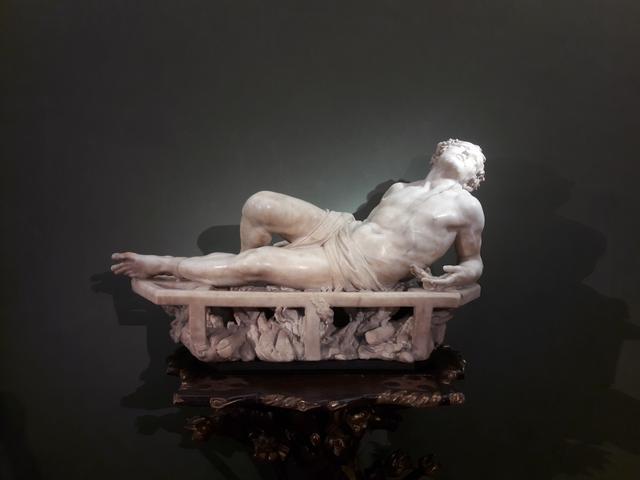Martyrdom of Saint Lawrence

Martyrdom of Saint Lawrence is an early sculpture by the Italian artist Gian Lorenzo Bernini. It represents the saint at the moment of his martyrdom, being burned alive on a grill. According to Bernini's biographer, Filippo Baldinucci, the sculpture was completed when Bernini was 15 years old, implying that it was completed in the year 1614. Other historians have dated the sculpture between 1615 and 1618. A date of 1617 seems likely.
The sculpture was created from a single block of Carrara marble. Restoration in 1997 revealed that Bernini used different tools to create different surface textures on various parts of the sculpture. The back of the grill has not been polished and finished in the same manner as the front, implying that the artwork was clearly intended to be viewed from the front only. A highly sculpted pedestal, made of wood and gilded with gold paint, was designed as a platform for the sculpture. There is a possibility that Bernini also executed this, although his design suggests that while it was a commission from the Strozzi family, it was made at a later date
Twentieth-century commentators have largely agreed on the sculpture's technical excellence. Rudolf Wittkower speaks of the "high degree of technical perfection, anatomical precision and an infallible sense of the organic coherence and structure of the human body." Irving Lavin sees, in the flesh-like quality achieved with marble, a criticism of Michelangelo, who mastered the design and anatomy but not the appearance of flesh.
Llamas also get attention. During the Baroque period, the ability to represent nature, such as in flames, water, flesh, in illusionistic marble would be a frequent challenge. Bernini's "attempt to depict leaping flames in sculpture is a tour de force" "convincingly depicting something as evanescent as flames, or as color-dependent as embers." Daniele Pinton talks about the "skillful interpretation of the flames under the grill, where the representation of an immaterial element like fire is magnificently in stone."
Charles Avery comes to see the technical innovation of work as his raison d'être. He cites the piece's naturalism, its emotional intensity, its use of subject matter that has never before been represented as a full three-dimensional sculpture, and concludes that "the work is a manifesto of his skill at the threshold of his adult career, as is the teacher". piece 'with which an artisan enrolls in his guild.'
© Tourblink